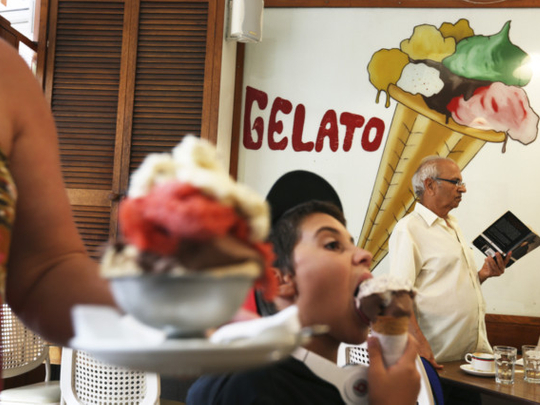
The Italians take their — and other people’s — food very seriously. Even if you wander into a corner café for a caffeine fix, you are likely to be met with stoic disapproval if you order cappuccino after breakfast or, God forbid, add brown sugar to your tea.
For people who like frozen desserts — ice lolly, ice cream, sorbet and, ah, gelato — this fervour is a good thing. There are thousands of handcrafted gelato shops in the country — 37,000 we are told. And a university, Carpigiani Gelato University, has made it its raison d’être to teach the world the secrets of the best kind. The institution, with 13 schools in five continents, boasts a museum that tracks the dessert to 12,000BC in Mesopotamia.
“Gelato is a balance between water and other ingredients such as sugars, fats, milk solids and fruit. It’s creamy and not hard. The artisan gelato also has less sugar than every product of the traditional pastry art, less air than industrial ice cream, and it is served at a higher temperature. You have a stronger taste and less calories to burn afterwards,” says Valentina Righi, Public Relations and Communication Manager of The Gelato World Tour and of the Carpigiani Group.
The world cup of gelatos
The 2013-14 World Tour, which comes to Dubai’s Mohammad Bin Rashid Boulevard for three days tomorrow is visiting eight cities in five continents. Three of its events have already attracted hundreds of thousands of people — 130,000 in Rome, 140,000 in Valencia and 70,000 in Melbourne. At each stage of the tour, 16 gelato artisans compete to produce the most delicious flavours — voted by the public, a technical jury and the competing artisans. A finale in Rimini, Italy, will award the title of World’s Best Gelato.
“The gelato connoisseur — please don’t call it ice-cream — first of all looks for flavour in a scoop. When tasting a good date or lemon gelato, close your eyes and try to feel the fruit, the passion of the gelato artisan who chose high-quality ingredients and balanced the recipe in the best way. The best gelato is the one that comes directly out of the machine, so gelato is always eaten fresh,” says Righi.
“You don’t want it to be shiny, as this would reflect on an amount of water that still needs to be frozen. Overall it looks dry. A good structure is one that holds the peak like a meringue,” she says, explaining what to look for when voting.
Gourmet goodness
The best gelato needs top-of-the-line equipment. Righi lists “the latest and high-efficient batch freezers, pasteurisers, blenders, blast freezers, ageing tanks, displays, complete systems for inventing, producing, and storing gelato,” as essentials.
You can try making it at home — the university has shared some recipes — “it will be fun but don’t expect to get a gelateria-style result,” says Righi.
Not only do professional technologies guarantee a superior gelato but they also use a mixture of granulated sugar, dextrose and sucrose, a combination that imparts less sweetness to the gelato and keeps it softer and easier to spread.








